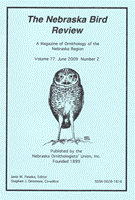Nebraska Ornithologists' Union

Nebraska Bird Review
Date of this Version
12-2023
Document Type
Article
Citation
Nebraska Bird Review, volume 91, number 4, December 2023, pp. 126–148.
Abstract
As in the last few fall seasons, late departure dates continue to increase in number. This is often attributed to a warming climate but may also result from increased observer activity and usage of eBird. Late dates are probably the most important aspect of this report, most prominent the record late fall dates for Ruby-throated Hummingbird, Sanderling, Bank Swallow, and Cassin’s Sparrow. Although these species are taxonomically diverse, there were species group concentrations of late dates, notably among shorebirds. Examples were Marbled Godwit for which the four latest reports this fall were four of the latest six fall dates on record, and Stilt Sandpiper, whose four latest dates this fall were four of the latest five on record. Furthermore, no fewer than 11 species recorded 2nd–4th latest dates on record, including 2nd latest Least Flycatcher and Northern Parula, along with Brown Thrasher and Hermit Thrush for the Panhandle.
A discouraging issue regarding latest dates was the early departure of Louisiana Waterthrushes; none were reported after Jul, likely reflecting the drying of streams in eastern Nebraska due to severe drought and presumed associated reduction in food supply. This species is well known as an indicator of stream quality.
Another noteworthy category of interest is high and low numbers. In general, high numbers do not reach the very high numbers reported in previous years, possibly attributable to a general decline in bird numbers overall, as pointed out in some recent popular nationally distributed articles. Although not spectacular, record or near-record high single observer-single location fall counts were reported for Sora at 130, Smith’s Longspur at 65–75, Lark Sparrow at 150, White-crowned Sparrow at 295, Brown-headed Cowbird at 10,000, and Canada Warbler at 17. Perhaps more indicative of current trends in numbers are reports for Western Grebe and Franklin’s Gull. The highest count reported this fall for Western Grebe was 1300, minuscule by comparison to previous high tallies of 30,000+ during the same fall staging period. Although the highest count reported this fall for Franklin’s Gull was 64,000, this is only the 4th highest fall count on record for the state.
Fall season often contains reports relating to nesting and breeding range expansion. In the last few years two species, Red-shouldered Hawk and Pileated Woodpecker, have been prominent in northwestward increases in reports, although not associated with documented nesting. Both, along with Broad-winged Hawk, have presumably followed maturation of riparian forests along westerly waterway corridors and are discussed in more detail in their respective accounts below. Notable in the Panhandle are continuing reports of Common Raven, recently new in modern times for the state, and Western Flycatcher, new for the Wildcat Hills. A new location for documented nesting of Mississippi Kite is Hastings, Adams Co, where photographs were provided of a newly fledged juvenile. Another expansion of range, although likely previously present but overlooked, are reports in Scotts Bluff Co of Hairy Woodpecker’s western subspecies Leuconotopicus villosus monticola. And the 4th Grant Co record of Northern Cardinal suggested continuing westward range consolidation there.
Prominent this fall were east-west displacements. Whether these displacements result from unexpected weather events possibly related to climate change is conjectural. Among eastern species west in fall, there was a first Panhandle record Yellow-throated Warbler (see article on page 155), and in the west and west central the 5th Sedge Wren, 8th Bay-breasted Warbler, 12th Northern Parula, and 12th and 13th Philadelphia Vireos. Not as remarkable but also farther west than expected were American Woodcock, Blue-headed Vireo, and Fox Sparrow. Western species eastward were highlighted by a far out of range Cassin’s Kingbird in Phelps Co, and a Clark’s Nutcracker in Gosper Co, the latter seen by many at the NOU meeting in the area. Almost as surprising was the third Sage Thrasher east of the Panhandle, and lastly and less surprising, easterly Yellow-rumped (Audubon’s) Warbler and Rock Wren.
This was not a great fall for state level rarities, although prominent was the 4th Groove-billed Ani, photographed in Cherry Co but not relocated subsequently. Seemingly old hat, despite being only the 2nd state record, was a Limpkin in Dakota Co. Pacific Wrens provided the 3rd and 4th state records, and a Parasitic Jaeger the 7th, the latter also an NOU meeting discovery. Additional noteworthy rarities were the 9th fall Hooded Warbler, a Black-throated Blue Warbler, and fall rarities Ruddy Turnstone, Red-throated Loon, and Blackpoll Warbler. Interesting finches were a widespread influx of Red Crossbills, mostly expected Type 2, but also Type 4 and Type 3, the latter for only the second time. There were three reports of Evening Grosbeak, two of which were recorded as Type 1, indicative of an easterly movement of this West Coast call type.
Included in
Ornithology Commons, Population Biology Commons, Poultry or Avian Science Commons, Zoology Commons


Comments
Published by the Nebraska Ornithologists’ Union, Inc.